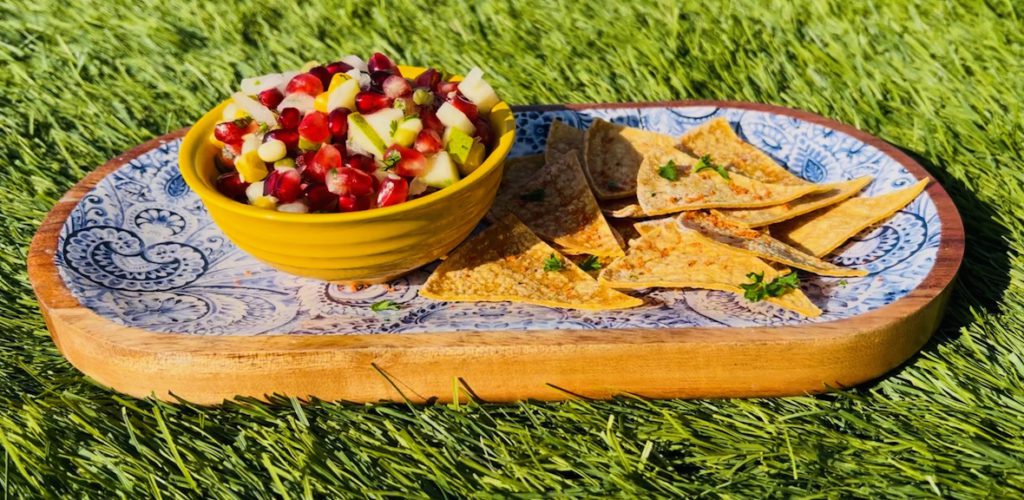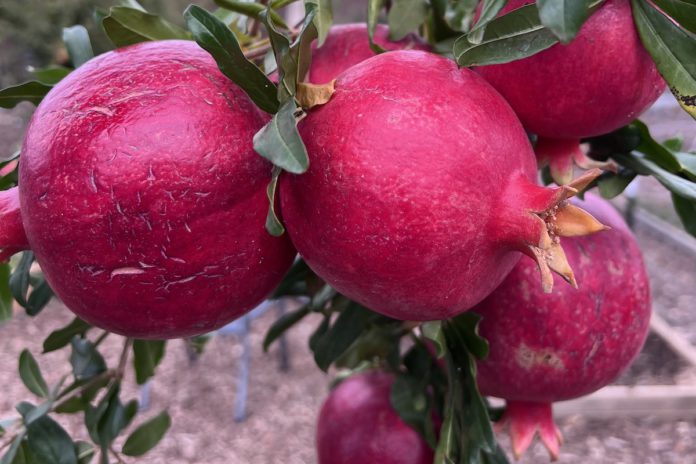While I become exhausted from a long summer, my pomegranate trees love the heat and can go on and on without breaking a sweat. Requiring relatively little care and upkeep, pomegranate is fairly easy to grow into a tree, shrub or a bush. It can be planted as a bare root, a young plant or from cuttings. As a home gardener, I do not have any personal experience in growing a pomegranate tree from seed, although I’ve heard it can be done, and I might experiment with that someday.
Pomegranates grow well in zones 8-10 but some labels include zone 7 too. They need a location that gets full sun for over eight hours per day. Ones that receive less than this amount of sunlight will still grow but might not fruit well, if at all. Young pomegranate plants need consistent watering and a balanced fertilizer, but once established, they don’t bother the gardener much. Pomegranate trees are generally pest-resistant, and I have easily been able to take care of any issues they encountered. If I spot aphids, which can typically be seen in an over fertilized plant that has lots of new growth, I simply wash them away with a water hose every few days. If your plant is set up to be watered by drip irrigation, make sure that the emitter is not sitting too close to the base of the trunk to avoid rot.
Pomegranate trees can either be ornamental or fruit-bearing. Ornamental cultivars have showy flowers and may also produce inedible fruit. Both types of trees are either self-pollinating or cross-pollinated by insects or hummingbirds. Planting multiple trees nearby can improve fruit setting. Once the fruit has set, it takes six months or so to be ready. One indication of readiness that some gardeners go by, is the fruit beginning to crack open. Although this method is easy, it can reduce shelf life. I utilize cracking to determine readiness for the first few fruits and then harvest the rest, definitely before any rain. However, the fruit can also crack prematurely due to inconsistent watering or excessive rain before the fruit is ready.
I have two kinds of pomegranate trees in my backyard: eversweet and cranberry, which require similar care and upkeep. When I first planted them, I amended the naturally occurring clay soil in my backyard with compost. Initially, the plants needed to be watered regularly, but once they had established, the rains took care of the irrigation in the winter. In spring and summer, deep watering once every week was all I did. The years I gave them fertilizer, the trees put on lush leaves, but the years I did not fertilize, I didn’t notice any difference in fruit quality. It appears that the trees did not mind some neglect as long as they were getting enough sunlight and water.
Pomegranate can be trained as trees, espalier, or as arching shrubs. Training them to grow as trees requires skill and patience and could result in reduced harvest depending upon what needed to be pruned away for the desired shape. During pruning and harvesting, be sure to wear protective gear to protect against the plant’s big woody thorns. Once the fruit has been harvested and the tree has shed its leaves, the tree can be pruned. I have kept mine at a height where the fruit is accessible without a ladder.
Upon harvesting, the fruit can be enjoyed right away, stored at room temperature for a week or two or stored in the refrigerator in a paper bag for about four weeks. If storing the fruit, don’t forget to check for any fruit that is developing mold or rotting. The extracted arils can be frozen and used as desired. To open the fruit, slice off the top and bottom ends with a sharp knife. Then slice it along the sides and pull apart to reveal the juicy arils, gently separating them from the pith. The arils can pop open and squirt out juice. Some people suggest taking out the arils under water, but I prefer to just be careful.

When it comes to the recipes with pomegranate, an important ingredient is patience. It takes time to open the fruit to take the arils out. While I can eat the pomegranate arils as is or in salads and smoothies, making a salsa takes it to the next level for an upcoming get together or ups the game for an ordinary menu. Mix together pomegranate arils, finely diced white onions, mangoes, finely chopped mint leaves, salt and pepper to taste and a squeeze of lime or lemon. Serve with freshly baked tortilla chips. If raw is not up your alley, then you can juice pomegranate or make syrup. Other than fruit dishes, pomegranate also makes the best fall gifts for family and friends. Our family also shares with the local food banks and at places of worship that accept such donations.
Note: This article gives an overview of growing plants, sun and soil requirements, moisture needs etc. Plant health and growth will vary based on various factors. This article is intended for gardening and culinary inspiration only. Please consult your healthcare provider should you have any questions or concerns about adding any new foods or ingredients to your diet. Also, I have used the term “tree” to refer to a pomegranate plant, tree, shrub or bush for ease of reading.




